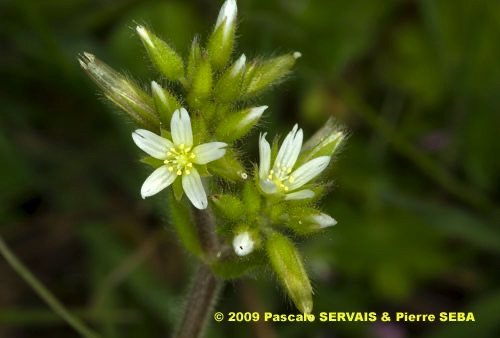
Cerastium glomeratum Thuill.
Fam. : Caryophyllaceae
© Pascale SERVAIS & Pierre SEBA, 2018. Tilo Botanica: Flore de Tilos et du Dodécanèse / Flora of Tilos and of the Dodecanese
English translation by Brenda Bradbury, Howard Bradbury and Stéphane Léonard
Plante herbacée, hermaphrodite, à tiges érigées, velues.
Feuilles opposées décussées, simples, elliptiques à ovales, velues, sans stipules.
Fleurs à symétrie radiaire, blanches, de 5 à 10 mm de diamètre, réunies en cymes bipares serrées de 20 à 25 mm de long. Corolle à 5 pétales libres, ciliés à la base, échancrés, ordinairement plus courts que le calice. Calice à 5 sépales libres, verts, poilus, souvent à pointe brun pourpre. 10 étamines. 5 styles alternant avec les pétales. Ovaire supère.
Fruits, capsules à 10 dents égales, plus longues que les sépales qui les entourent.
___________________________
Plant herbaceous, hermaphrodite. Stems erect, hairy.
Leaves opposite decussate, simple, elliptic to ovate, hairy, without stipules.
Flowers radially symmetrical, white, from 5 to 10 mm in diameter, joined together in tight dichasial cymes from 20 to 25 mm long. Corolla with 5 free petals, ciliate at the base, indented, usually shorter than the calyx. Calyx with 5 free, green, hairy sepals, often with a brown purple point. 10 stamens. 5 styles alternating with the petals. Ovary superior.
Fruits, capsules with 10 equal teeth, longer than the sepals which surround them.
Descripteurs / Identifying features
1
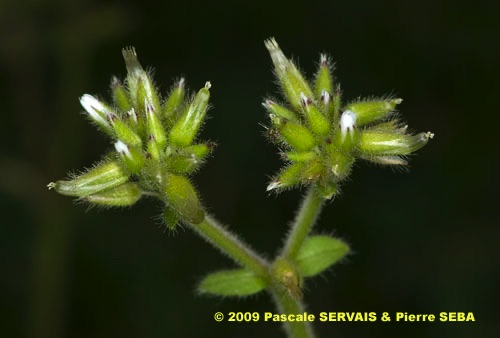
2
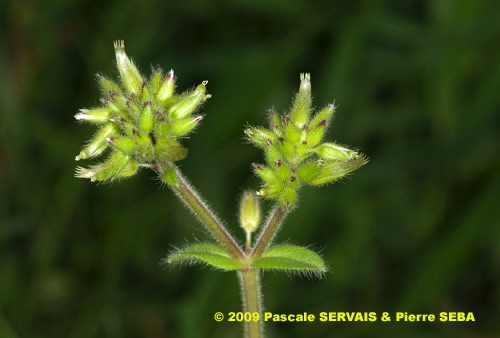
3
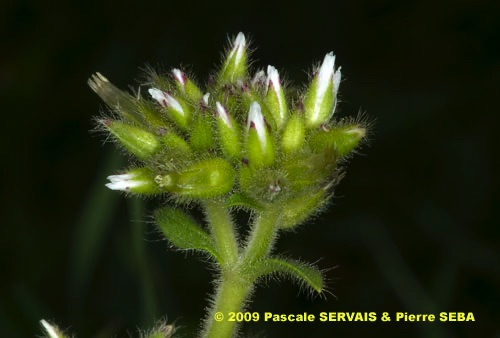
4
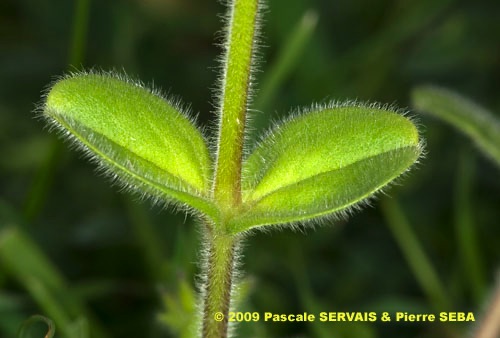
5
Étymologie / Etymology :
Cerastium : emprunt du grec ancien κέρας, -ατος (nom) = la corne,
en référence à la forme de la capsule.
Glomeratum : emprunt du latin glomeratus, -a, -um (part. passé)
[ < glomero, -as, -are (verbe) = mettre en pelote, grouper en tête
arrondie ] = en forme de tête arrondie, en référence à la forme
de l’inflorescence.
Cerastium : borrowed from Classical Greek κέρας, -ατος (noun)
= horn, referring to the shape of the seed capsule.
Glomeratum : borrowed from Latin glomeratus, -a, -um (past participle)
[ < glomero, -as, -are (verb) = to gather into a ball, to form into
a round head ] = in the shape of round head, referring to the shape
of the inflorescence.
Synonymes / Synonyms :
Cerastium apetalum Dumort.
Cerastium brachycarpum Stapf
Cerastium fulvum Raf.
Cerastium glomeratum var. apetalum (Dumort.) Mert. & W.D.J.Koch
Cerastium glomeratum var. corollinum (Fenzl) Rouy & Foucaud
Cerastium glomeratum var. eglandulosum Mert. & W.D.J.Koch
Cerastium hirsutum Mühl.
Cerastium obtusifolium Lam.
Cerastium ovale Pers.
Cerastium viscosioides P.Candargy
Cerastium viscosum L.
Cerastium viscosum var. apetalum (Dumort.) Fenzl
Cerastium viscosum var. corollinum Fenzl
Cerastium viscosum var. tenellum Gren.
Cerastium vulgatum L.
Cerastium vulgatum var. subviscosum Rchb.
Myosotis vulgaris Moench
Stellaria glomerata (Thuill.) Jess.
Stellaria vulgata Link
Noms vernaculaires / Common names :
Nom français / French name :
Céraiste aggloméré.
Nom grec / Greek name :
Κεράστριο.
Noms anglais / English names :
Sticky chickweed — Sticky mouse-ear.
Noms allemands / German names :
Knäuel-Hornkraut — Knäuelblütiges Hornkraut.
Nom espagnol / Spanish name :
Lapilla.
Nom italien / Italian name :
Peverina dei campi.
Habitat :
Prairies - Lieux pierreux - Lieux incultes.
Meadows - Stony places - Waste ground.
Île / Island :
Tilos.
Hauteur / Height range :
De 5 cm à 30 cm.
From 5 cm to 30 cm.
Floraison / Flowering time :
De février à avril.
From February to April.
Groupe / Classification :
Dicotylédones.
Dicotyledons.
Pérennité / Lifespan :
Annuelle.
Annual.
Description :
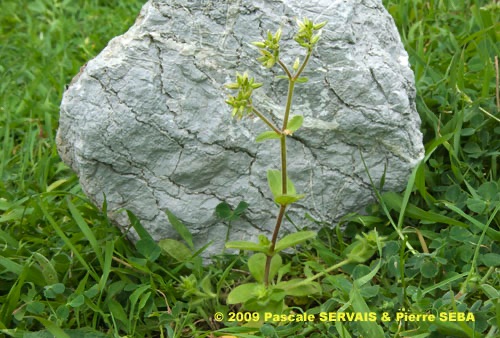
6
Photo 1 :
Localisation / Location : Tilos, Livadia, Aghios Stephanos
Date : 25/03/2009
GPS : Lat. 36,40863° N / Long. 27,39761° E / Alt. 7 m
Type : Photographie numérique / Digital Photograph (10 mégapixels)
Photo 2 :
Localisation / Location : Tilos, Megalochorio, Aghios Andonis
Date : 24/03/2009
GPS : Lat. 36,45765° N / Long. 27,33259° E / Alt. 3 m
Type : Photographie numérique / Digital Photograph (10 mégapixels)
Photo 3 :
Localisation / Location : Tilos, Megalochorio, Aghios Andonis
Date : 24/03/2009
GPS : Lat. 36,45765° N / Long. 27,33259° E / Alt. 3 m
Type : Photographie numérique / Digital Photograph (10 mégapixels)
Photo 4 :
Localisation / Location : Tilos, Megalochorio, Aghios Andonis
Date : 24/03/2009
GPS : Lat. 36,45765° N / Long. 27,33259° E / Alt. 3 m
Type : Photographie numérique / Digital Photograph (10 mégapixels)
Photo 5 :
Localisation / Location : Tilos, Megalochorio, Aghios Andonis
Date : 24/03/2009
GPS : Lat. 36,45765° N / Long. 27,33259° E / Alt. 3 m
Type : Photographie numérique / Digital Photograph (10 mégapixels)
Photo 6 :
Localisation / Location : Tilos, Megalochorio, Aghios Andonis
Date : 24/03/2009
GPS : Lat. 36,45765° N / Long. 27,33259° E / Alt. 3 m
Type : Photographie numérique / Digital Photograph (10 mégapixels)

Google Maps
Google Maps
Google Maps
Google Maps
Google Maps
Google Maps